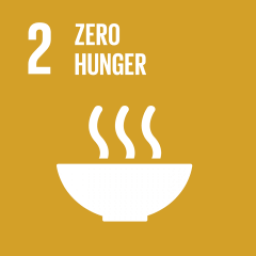SDG 2 - Zero Hunger

End hunger, achieve food security and improved nutrition and promote sustainable agriculture
Stunting, which can occur when a child under five years of age and does not receive adequate nutrition, remains an issue in some of our Pacific countries. One in four children in Vanuatu, one in three children in the Solomon Islands and one in two children in PNG are reported as being stunted. Poorly nourished children are more vulnerable to disease, tend to show lower performance in school, and are less likely to be productive adults.
At the same time, the prevalence of obesity in young children is increasing in parts of the region, although there is insufficient data to give a complete picture.
By 2030, end hunger and ensure access by all people, in particular the poor and people in vulnerable situations, including infants, to safe, nutritious and sufficient food all year round
Indicator 2.1.1: Prevalence of undernourishment
![]() Download Metadata for indicator 2.1.1
Download Metadata for indicator 2.1.1
Indicator 2.1.2: Prevalence of moderate or severe food insecurity in the population, based on the Food Insecurity Experience Scale (FIES)
NOTE: this indicator is not one of the 132 indicators in the Pacific SDG indicator subset
By 2030, end all forms of malnutrition, including achieving, by 2025, the internationally agreed targets on stunting and wasting in children under 5 years of age, and address the nutritional needs of adolescent girls, pregnant and lactating women and older persons
Indicator 2.2.1: Prevalence of stunting (height for age <-2 standard deviation from the median of the World Health Organization (WHO) Child Growth Standards) among children under 5 years of age
![]() Download Metadata for indicator 2.2.1
Download Metadata for indicator 2.2.1
Indicator 2.2.2: Prevalence of malnutrition (weight for height >+2 or <-2 standard deviation from the median of the WHO Child Growth Standards) among children under 5 years of age, by type (wasting and overweight)
By 2030, double the agricultural productivity and incomes of small-scale food producers, in particular women, indigenous peoples, family farmers, pastoralists and fishers, including through secure and equal access to land, other productive resources and inputs, knowledge, financial services, markets and opportunities for value addition and non-farm employment
Indicator 2.3.1: Volume of production per labour unit by classes of farming/pastoral/forestry enterprise size
NOTE: this indicator is not one of the 132 indicators in the Pacific SDG indicator subset
Indicator 2.3.2: Average income of small-scale food producers, by sex and indigenous status
Visualisation(s) not yet available
No data for indicator 2.3.2 is currently available.
By 2030, ensure sustainable food production systems and implement resilient agricultural practices that increase productivity and production, that help maintain ecosystems, that strengthen capacity for adaptation to climate change, extreme weather, drought, flooding and other disasters and that progressively improve land and soil quality
Indicator 2.4.1: Proportion of agricultural area under productive and sustainable agriculture
Visualisation(s) not yet available
View 2.4.1 data on PDH.stat
By 2020, maintain the genetic diversity of seeds, cultivated plants and farmed and domesticated animals and their related wild species, including through soundly managed and diversified seed and plant banks at the national, regional and international levels, and promote access to and fair and equitable sharing of benefits arising from the utilization of genetic resources and associated traditional knowledge, as internationally agreed
Indicator 2.5.1: Number of plant and animal genetic resources for food and agriculture secured in either medium or long-term conservation facilities
Other 2.5.1 datasets available on PDH.stat:
- 2.5.1 Animal breeds for which sufficient genetic resources are stored for reconstitution
-
2.5.1 Operational in vitro gene bank for animal genetic resources
![]() Download Metadata for indicator 2.5.1
Download Metadata for indicator 2.5.1
Indicator 2.5.2: Proportion of local breeds classified as being at risk of extinction
NOTE: this indicator is not one of the 132 indicators in the Pacific SDG indicator subset
Increase investment, including through enhanced international cooperation, in rural infrastructure, agricultural research and extension services, technology development and plant and livestock gene banks in order to enhance agricultural productive capacity in developing countries, in particular least developed countries
Indicator 2.A.1: The agriculture orientation index for government expenditures
An Agriculture Orientation Index (AOI) greater than 1 reflects a higher orientation towards the agriculture sector, which receives a higher share of government spending relative to its contribution to economic value-added. An AOI less than 1 reflects a lower orientation to agriculture.
![]() Download Metadata for indicator 2.A.1
Download Metadata for indicator 2.A.1
Indicator 2.A.2: Total official flows (official development assistance plus other official flows) to the agriculture sector
NOTE: this indicator is not one of the 132 indicators in the Pacific SDG indicator subset
Correct and prevent trade restrictions and distortions in world agricultural markets, including through the parallel elimination of all forms of agricultural export subsidies and all export measures with equivalent effect, in accordance with the mandate of the Doha Development Round
Indicator 2.B.1: Producer Support Estimate
NOTE: this indicator is not one of the 132 indicators in the Pacific SDG indicator subset
Indicator 2.B.2: Agricultural export subsidies
NOTE: this indicator is not one of the 132 indicators in the Pacific SDG indicator subset
Adopt measures to ensure the proper functioning of food commodity markets and their derivatives and facilitate timely access to market information, including on food reserves, in order to help limit extreme food price volatility
Indicator 2.C.1: Indicator of food price anomalies
NOTE: this indicator is not one of the 132 indicators in the Pacific SDG indicator subset